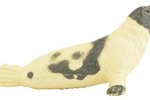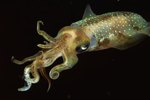
During late summer, salmon come from the oceans to spawn in rivers. Alaskan grizzly bears gorge themselves on the protein-rich salmon by wading into the rivers to catch them. The relationship between the salmon and grizzly bears is more complex than a simple predator-prey relationship, as the bears distribute nitrogen into the surrounding woodlands and forests.
Salmon Lifecycle
Salmon are born in rivers and spend their early life there. As they grow they swim out to sea and live their adult lives in the ocean. When they have reached full-size and are sexually mature they return to rivers to spawn. Most salmon will return to the river they were born in and make their way upstream to the place they were born. The trip is generally hazardous, as they have to work their way up rapids. Over 95 percent of salmon will die after they have spawned, the website Environmental Graffiti reports.
Alaskan Grizzly Bears
Grizzly bears tend to live solitary lives and normally hibernate from late fall to early spring through the harsh Alaskan winter. They have a varied diet, living on grasses, berries, insects and roots as well as small mammals and carrion. To survive through hibernation they must put on a thick layer of fat or they will not pull through. Fishing for salmon in late summer is the best way for them to get the food they can store as fat.
Fishing Bears
The bears generally catch salmon from rocks where the fish have to jump to reach the next level of the stream. Cubs develop their fishing technique by watching their mother, and some bears are better fishers than others. Bears must eat about 25 fish a day to put on enough fat to survive the winter hibernation. When fish are plentiful they might just eat the head and brains and the roe, or fish eggs. When fish are scarce they will try to steal each other's catch.
Impact on Other Species
The death of salmon feeds more than just the grizzly bears. The uneaten parts of the salmon carcases provide food for other animals, scavenger species and birds. The bears deposit partially-eaten carcases and nutrient-rich urine and feces which provide nitrogen to plant species. Nutrients are also washed down to estuaries which support large bird populations. The grizzly bears kill many salmon, but without the salmon the bears will not survive.
References
Resources
Photo Credits
-
Jupiterimages/Photos.com/Getty Images




